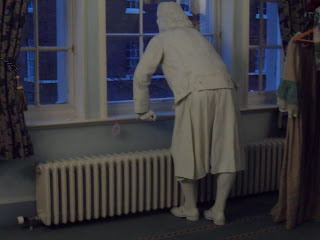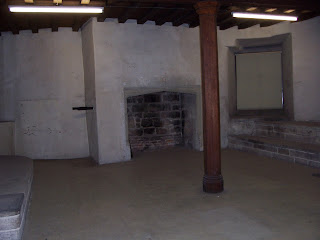So
you’ve got the tickets for your very first ghost hunt. Now what?
1,
Transport.
Make
sure you have the ‘SAT NAV’ code and address for where you are going especially
if you are the driver! Also check your
car, make sure it has enough of all those precious fluids it needs to function properly;
petrol/diesel – not all venues are in the middle of populated areas or where
there is a petrol station conveniently close at hand.
2,
Equipment.
All you really need is a working
torch and spare batteries. Many ghost
hunting teams have kit that they are wiling to lend and explain what they are
for and how they work. A camera perhaps,
but if you are going to use flash photography, please warn the people in your
group before you press the button to take that shot. The flash of a camera flash is blindingly
bright in the dark. It’s simple; say “flash” aloud before you flash!
Oh, and if you do borrow kit,
please give it back. Quite often it
belongs to a team member.
3,
Clothing.
It
may have been sunny all day on the date of your ghost hunt, but many hunts
start at 21.00hrs and go on until 02 – 03.00hrs the next day, while it may seem
obvious remember, it gets cold at night!
Not all venues are heated, tunnels and caves most certainly are not and
they stay cold all year round. I have
known people to turn up to a ghost hunt wearing a thin summer t-shirt, shorts
and strappy sandals, and by midnight be wanting to go home because they were
freezing. Yet Ghost Encounters have been
on a ghost hunt where it registered minus 12 inside – Tatton Old Hall, 4th
December, the year with all the snow – but we’re still here.
The answer is appropriate clothing! Trousers, socks (may be several pairs worn at once), jumper, coat, jacket, hat,
scarf, gloves – layers: that you can take off or put on as needed. And proper
footwear; sturdy trainers are good, spare boots if you are going outside. I wouldn’t suggest really heavy boots, unless you
have to tramp across open fields or rough ground to get there, as indoors they
can be clompy, which can be annoying on wooden floors in old echoic buildings. Whatever you decide to put on your feet
consider, ghost hunting involves quite a bit of walking and standing around; opt for warmth and comfort.
4,
Food.
Many
ghost hunting teams provide hot drinks but it might not always be possible as
some venues do not have electric power – check if you need to take a flask. Food, or snack, wise; unless it is stated on
your ticket that food is provided don’t count on it being. To help keep the costs down many ghost
hunting teams do not provide food. Take
you own, even a squashed cheese buttie tastes marvellous at 02.00hrs! You’d be surprised how hungry you can get while
ghost hunting; Ghost Encounters has an open biscuit box by the urn, and on a
busy night we can go through four packets of chocolate biscuits, not counting
other varieties.
5,
When there;
Don’t
turn up drunk or smelling of drink; you will not get in. The Public Liability insurance, which all
good teams will have, will not cover you if you are drunk or if you smell or
are under the influence of illegal drugs.
You will not get your ticket money back either.
Sign
in – it’s a fire regulation. During the
night you will work in small teams, possibly on your own at times, and should
for some reason the building have to be evacuated, you will want someone to
know you are out safely. Likewise, sign
out. Especially if you are going home
before the end of the ghost hunt, it saves people having to go and look for you
possibly at the risk of their own lives.
We like to hunt for ghosts, not make new ones.
Only
smoke in the designated area or face being asked to leave with no refund of
money and possibly having to pay the fine for a false call out if the Fire
brigade are involved.
A
good team will have a health and safety talk before the start of a ghost hunt; listen
to it and comply with it; it is after all for your safety. Always put your torch on before walking if
the lights are off, and never run off screaming no matter what happens. We would prefer it if you didn’t scream,
leave that to the Most Haunted crew; in real life it means someone has to come
and see what the matter is.
For
most of the night you will work in small teams with a Team Leader who is a
member of, in our case, Ghost Encounters and Alone In The Dark Entertainment
North West. If you are feeling scared, or
ill, etc., tell your Team Leader. Ghost
Encounters’ Team Leaders have radios on which they can call for first aid assistance,
yes we also have trained First Aiders.
Team
Leaders for Ghost Encounters and Alone In The Dark Entertainment will never
insist you take part in a particular activity but I would suggest you give it a
go, then, should you decide it isn’t for you, drop out of the activity and just
watch. Some people don’t like using
Talking/spirit/Ouija Boards but will happily do glass work; there is actually
very little difference between the two!
If you are worried that ‘something might come through’ say so. But isn’t that the whole point of what you go
on a ghost hunt for?
If
it does bother you most of the Talking Boards, (Ouija is a trademark registered
to Hasbro – the makers of My Little Pony etc.,), that Ghost Encounters and
Alone In The Dark Entertainment North West use have been manufactured by either John Lysons
or myself, and to my knowledge neither of us have been possessed! Furthermore all Ghost Encounters and Alone In
The Dark Entertainment North West Team Leaders know how to open Boards and close
them down properly and will show you how to if you ask.
“But
something might follow me home”. This is
highly unlikely. Most ghosts are
attached or attracted to the buildings and venues we visit not to us
personally. They have no reason to follow
you home as they already are home. I
only know of two occasions when members of Ghost Encounters and Alone In The
Dark Entertainment North West have been 'followed home' from ghost hunts, I’ll
tell you about them another time.
It is possible of course
that you have brought a ghost with you, probably a former family member who
either wishes to make contact if they can or just keep an eye on you, or even
your Guardian Angel (if you believe in them).
Now they will follow you home because that’s how they got to the venue!















